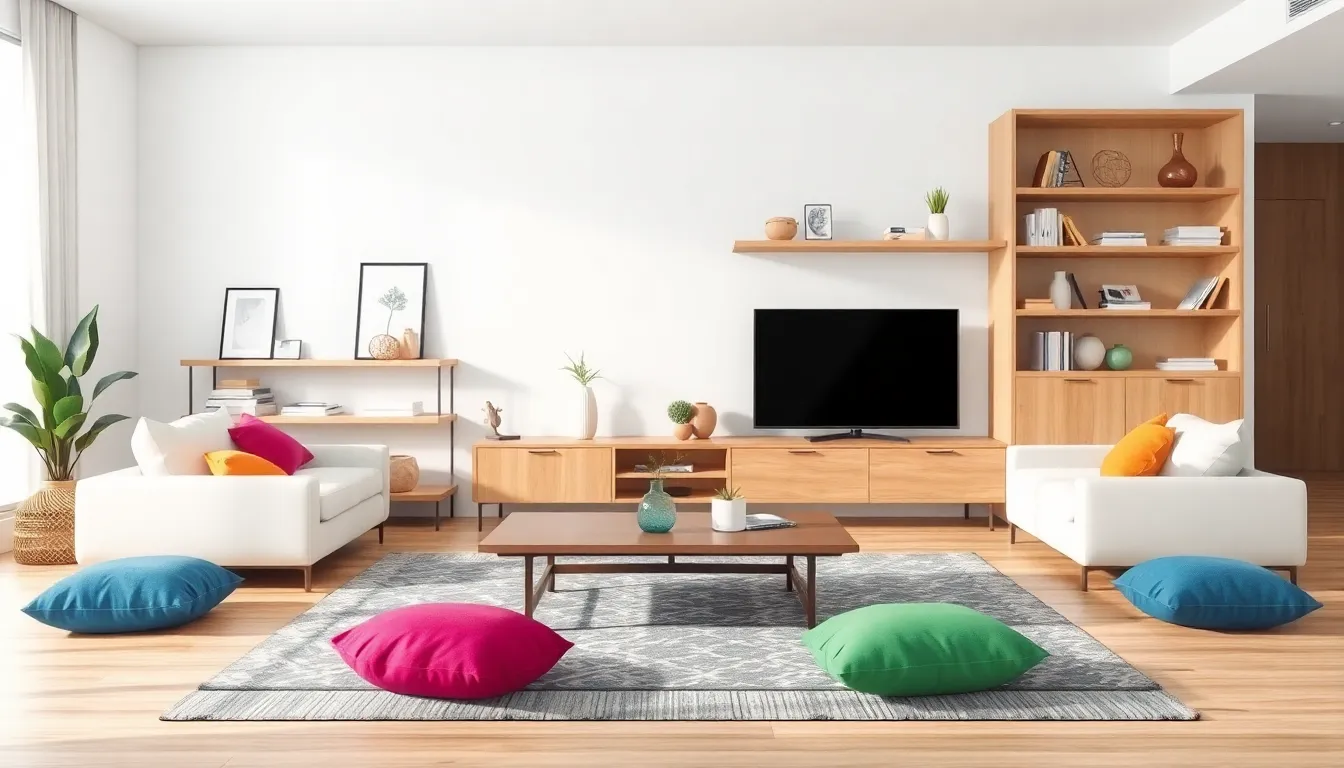Imagine a living room that feels like a breath of fresh air—no bulky sofa hogging all the space, just clean lines and open vibes. Minimalist living isn’t just a trend; it’s a lifestyle choice that allows for creativity and freedom. Without the traditional sofa, one can explore unique seating options like floor cushions or stylish poufs that invite conversation and spontaneity.
Ditching the sofa might sound radical, but it’s a chance to showcase personality while maximizing space. Plus, it’s an excellent excuse to finally embrace that quirky chair you’ve been eyeing. With a minimalist approach, every piece counts, turning your living room into a chic sanctuary that reflects who you are. So why not take the plunge and transform your space into a stylish haven that’s as functional as it is fabulous?
Table of Contents
ToggleUnderstanding Minimalist Living Room Design
Minimalist living room design focuses on simplicity and functionality. This approach encourages creativity and a personalized touch while maximizing space.
The Philosophy of Minimalism
Minimalism emphasizes intentional living and the reduction of excess. Prioritizing quality over quantity helps create a serene environment. A minimalist space often relies on clean lines, neutral colors, and uncluttered surfaces. This philosophy aligns with the belief that less is more, fostering clarity and peace. Each item selected serves a purpose, allowing for a more mindful interaction with the living space.
Benefits of a Sofa-Free Space
Opting for a sofa-free living room creates an open, airy atmosphere. Flexibility increases as versatile seating options, such as floor cushions and poufs, become available. Moving furniture around is easier, facilitating various configurations for social gatherings or relaxation. This design enhances accessibility and invites movement, which encourages engagement with the space. An absence of a traditional sofa also enables a unique style that reflects personal taste, transforming the room into a distinctive sanctuary.
Key Elements of a Minimalist Living Room Without Sofa

The minimalist living room focuses on essential design principles while eliminating the traditional sofa. This approach fosters a serene space characterized by simplicity and intentionality.
Essential Furniture Choices
Select multifunctional furniture pieces to maximize space. A low-profile coffee table serves as a central point and provides additional surface area. Opt for shelves that display decor without cluttering. Choose a stylish media console that balances functionality and aesthetics. Incorporate a cozy rug to define the space visually. Minimalist designs often feature natural materials like wood or metal, offering warmth and texture without overwhelming the room. These elements ensure a clean, uncluttered look while serving practical purposes.
Creative Seating Alternatives
Explore seating alternatives that promote flexibility and engagement. Floor cushions present a casual vibe, inviting relaxation and comfort. Poufs act as versatile seating and can double as footrests or side tables. Bean bags create a playful environment, appealing to a variety of styles. Stools add height and can be easily moved, accommodating changing needs. Benches provide long seating options without occupying excessive space. Each choice allows personal expression while maintaining a minimalist feel, contributing to a unique, inviting atmosphere.
Tips for Styling Your Sofa-Less Living Room
Embrace unique design strategies to create a functional living space without a sofa. Explore creative ideas that maximize area and express personality.
Utilizing Space Effectively
Focus on multifunctional elements within the living area. Low-profile coffee tables serve dual purposes, offering a surface for drinks and a spot for storage. Consider floor cushions, poufs, and stools as flexible seating options, encouraging movement and interaction. Arranging furniture in a way that promotes conversation fosters a welcoming atmosphere. Open floor plans enhance flow, ensuring space feels inviting while remaining uncluttered. Placing items like plants or art can define zones, allowing different activities in one area.
Incorporating Color and Texture
Integrate various hues to add depth and interest. Neutral tones create a calm foundation, while splashes of bold colors can energize the environment. Use textiles such as woven rugs and fabric cushions to introduce warmth and richness. Different textures play a vital role in enhancing visual appeal; mixing smooth surfaces with rough ones creates a balanced look. Art pieces and decorative accents contribute layers, showcasing individual style while maintaining clarity. Thoughtful combinations of color and texture ensure the space remains inviting and stylish.
Common Mistakes to Avoid
Creating a minimalist living room without a sofa comes with its challenges. Awareness of common mistakes can help one craft an inviting and functional space.
Overcrowding the Space
Overcrowding can clutter the living area. It’s essential to choose only key items that serve a purpose. Select a few eye-catching pieces instead of numerous smaller items. Unwanted furniture can overwhelm the visual appeal and reduce openness. Maintaining ample space promotes movement and relaxation. Prioritizing versatility enhances functionality, supporting a sofa-free design. Balance simplicity and style for a more serene atmosphere.
Neglecting Functionality
Functionality plays a vital role in creating a comfortable living environment. Choosing furniture solely for aesthetics might lead to discomfort. It’s crucial to incorporate multifunctional pieces, like storage ottomans or nesting tables. Seating should encourage gatherings, making comfort a priority. If furniture lacks practicality, engagement within the space decreases. Thoughtful placements of elements can foster a welcoming environment. Ensure that each piece contributes to the overall usability of the room.
Embracing a minimalist living room without a sofa opens up a world of design possibilities. This approach not only maximizes space but also allows for personal expression through unique seating options. By focusing on simplicity and intentionality, individuals can create a serene environment that reflects their style.
The use of multifunctional furniture and thoughtful arrangements fosters an inviting atmosphere. Incorporating textures and colors enhances the room’s warmth while maintaining a clean aesthetic. Avoiding overcrowding ensures that each piece serves a purpose, contributing to both functionality and comfort.
Ultimately, a sofa-free living room encourages engagement and creativity, making it a true reflection of personal taste and lifestyle.





